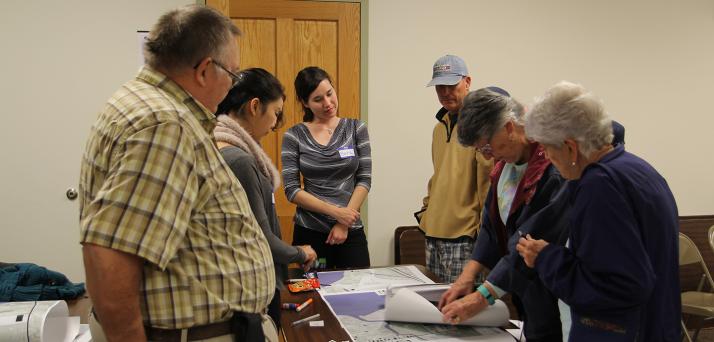
By Edith Fikes
The Town of Urbana and the Town of Brutus have received separate grants from New York State Department of State’s (NYS DOS) Regional Economic Development Councils Consolidated Funding Application (CFA) to continue work on projects that were developed in partnership with Design Connect, AAP’s multidisciplinary, student-run design and planning organization.
Each semester, Design Connect participants form small groups that collaborate with stakeholders in Upstate New York towns to provide design and planning resources where they might not be readily available. Grants that support project implementation are largely the result of Design Connect’s contribution of site research, analysis, and feasible design plans as well as strong efforts by administrators and community members to identify funding resources such as the CFA.
Design Connect began collaborative research with the Town of Urbana in 2015 to work on a portion of the town’s master plan that would improve public access to Keuka Lake’s Champlin Beach. In fall 2016, a new group of students, led by Tess Ruswick ’18, returned to the project to continue site research, analysis, and develop the plans for an old railway conversion — or “rails-to-trails” project — that would connect two public lakefront parks with a bridge and footpath.
The 2016 team worked with the municipality, local residents, and the nonprofit organization Friends of the Hammondsport Area Trails and Parks, to draft a site plan that was used in part toward the town’s CFA proposal to the NYS DOS. Urbana’s administration and the Friends group were notified in fall 2017 that they would receive $683,603 as part of NYS DOS’s Local Waterfront Revitalization Program. The funds will cover 75% of the budget for the creation of the new connective pathway, making the grant what Urbana Town Supervisor Dave Oliver referred to as, “the linchpin that holds everything together.”

Overview of Design Connect’s recommendations for the Town of Brutus’s Centreport Aqueduct Park expansion. diagram / Kelly Farrell ’18
“I’m really happy that the Town of Urbana received the funding to continue the work that has been started,” commented Ruswick. “The community is very invested in creating a network of open spaces and trails along the area’s waterfront, and it was amazing to listen to their thoughtful ideas and incorporate them into a vision that I’m very excited to see come into fruition.”
Students who participated in the Urbana Design Connect project include Angela Agustin ’17, Raquel Blandon (B.S. URS ’18), Alastair Chang (B.S. URS ’18), Luwei Chen (M.R.P. ’18), Gabe Curran (M.R.P. ’18), Elizabeth Fabis ’19, Natalia Gulick (B.Arch. ’21), Richa Gupta (M.R.P. ’18), Isabel Ling (B.S. URS ’19), Ruswick, Yu Shao (B.S. URS ’19), and Sara Vanderbroek ’18.
Also in fall 2016, the Town of Brutus Design Connect group, led by Kelly Farrell ’18, worked with local administrators and residents to create a site plan and cost analysis for the town’s Centreport Aqueduct Park expansion. The project’s initiation followed the gift of an adjacent 3.85-acre parcel that nearly doubles the area of the existing park. The Centreport Aqueduct is on the National Register of Historic Places and the surrounding park is part of the Erie Canal Trail that extends from Albany to Buffalo, New York. The town was in need of guidance on how best to make improvements to the existing infrastructure while integrating elements of the additional acreage, including a substantial pond, open and shaded areas, and a new point of public access to the park.
“The Design Connect opportunity was introduced at a unique time as the town had recently been given an additional parcel of land with a swampy pond on it,” commented Town of Brutus Clerk Angela Skellington. “The task given to the team was to include that parcel in the whole park and offer suggestions on the best way to do it. The team worked professionally, asked questions, studied the area and its history, held public meetings, and presented a final product with some wonderful and attainable goals. Design Connect’s report gave the town a very vivid picture of what our park could become.”

The town of Brutus’s administration used the report to submit a CFA for the fall 2017 cycle and was granted $352,000 from the NYS DOS’s Environmental Protection Fund Grant Program for Parks, Preservation, and Heritage. The funds will support several specific elements included in the Design Connect plan including the repair and stabilization of the historic aqueduct, the addition of pull-off parking along the public roadway, and the implementation of a trail, boardwalk, and sitting dock around the pond to ensure safe and open access to the water and park as a whole.
Students who participated in the Town of Brutus Design Connect project include Jacob Dilson ’18, Farrell, Katharine Guan ’19, Alfie Rayner (B.S. URS ’19), Andrew Roblee (M.A. HPP ’17), Victor Tran (B.S. URS ’18), Andrew Varuzzo (M.R.P. ’18), and William Wong (B.S. URS ’17).
“I would highly recommend this experience for any other community,” added Skellington. “I think it is a win-win for us as well as for the Design Connect team.”
Design Connect was originally formed in 2008 and officially became a Cornell University Student Organization in 2010 and is advised by CRP professor and director of the Historic Preservation Planning program, Michael Tomlan, who remarked, “We mark our 10th anniversary this spring proudly knowing that Design Connect has provided at least four field teams every semester, assisting more than 80 projects throughout the region.”
Design Connect draws student participation from across the university and provides opportunities for group members to gain direct experience working with communities and municipalities on planning and design possibilities. Project plans are informed by democratic decision-making processes and sensibilities that reflect concern for public space and the natural environment. Spring 2018 Design Connect groups will work on four projects including one at a local site in Ithaca’s Collegetown, as well as sites located in Penn Yan, Hamilton, and Utica, New York.
Original post can be found on the Cornell AAP event page.